
I did a week’s deep dive on Joseph Losey, years ago. This is another, larger deleted sequence from the essay I’m working on. Poor Evan Jones got cut, because it was just too sprawling and diffuse.
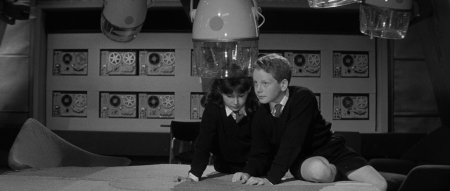
Joseph Losey had been forced to leave to avoid testifying before the House Unamerican Activities Committee. He would gradually, by talent and sheer force of will, reinvent himself: in America he had specialised in thrillers; in Britain he slowly transformed into a maker of art films, a form which had almost no history in the UK.
But his first collaboration with writer Evan Jones was made for Hammer films. The Damned (1961), AKA These Are the Damned, is often falsely grouped with the sci-fi thriller Village of the Damned (1960) whose success the studio probably wanted to cash in on. In it, a teenage gang’s conflict with a visiting American (the dependably dull MacDonald Carey) brings them into contact with a group of children are kept underground and rendered immune to radiation, primed to take over the world “when the time comes,” as the head of the project says, bears more relation to Losey’s debut The Boy with Green Hair (1947) and his juvenile delinquent picture The Sleeping Tiger (1954).
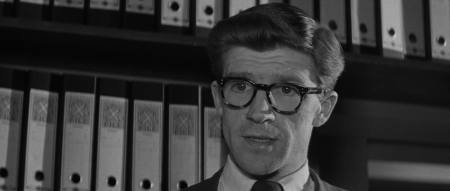
Look behind him! It’s The X-Files!
Jones was tasked with adapting H.L. Lawrence’s source novel, The Children of Light after blacklistee Ben Barzman’s legal troubles stalled his progress on the script. Talking to Michel Ciment, Losey sketched out a brief bio of his chosen replacement: “Actually he hadn’t, so far as I can remember, ever worked on a film before. His parents were landowners in Jamaica. He’s milky-coloured, and he makes no secret that his father was black. He was educated at Oxford, I think. His play was pretty strong and dealt with the relationships of a landowner and his peasants in Jamaica. We had a certain political kinship and we got along very well in other respects, too.”
The job had to be done fast: at Losey’s urging, he largely threw out the original story, keeping only the premise. He was still writing until the day before shooting started. It’s a bizarre movie with many dysfunctional elements: disparate plot threads are introduced in haphazard fashion, and the attempts to wrestle with youth culture are terribly square and unconvincing. The sci-fi aspects made Losey very uncomfortable too: he couldn’t believe in them. But somehow a certain stark force is realized: the subterranean children, who are cold to the touch, are a metaphor for both Britain’s public school system (in Britain, for some topsy-turvy reason, private schools are referred to as public schools) and for the populace as a whole: literally kept in the dark. One very effective touch is that rather than building up a single villain in charge of the scheme, Jones emphasizes the team, which includes favorite Losey actors Alexander Knox and James Villiers.
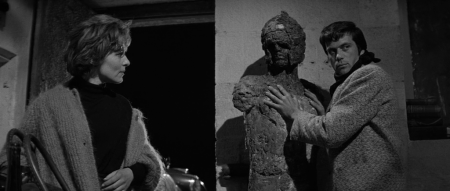
Though nobody involved can breathe convincing life into the gang of delinquents led by a young Oliver Reed, who has not yet learned to whisper huskily, there are commendable efforts to avoid the tabloid news clichés: Reed’s character is obsessed with protecting his sister’s purity, “…because you’ve never had a girl yourself,” she charges. Losey’s command of visuals was increasing as he found more and more talented collaborators. Here, production designer Richard MacDonald creates frightening and dreamlike caves and classrooms for the little troglodytes, enhanced by Elizabeth Frink’s sculptures of wingless, decayed birds. “Life has the power to change,” intones Knox, “After the first great explosion, strange, wonderful flowers, unknown before, bloomed in the desert.” The film continually aspires towards poetry, is dragged down by plodding convention, then soars again.

Arthur Grant’s black-and-white widescreen images are edited by Reginald Mills, who cut Michael Powell’s classics and would go on to cut The Servant (1963, written by Pinter) and King and Country (1964) for Losey. The sound design, dominated by crashing surf, anticipates the roaring breakers that give Losey’s later Boom! (1967) its title (“the shock of each moment of being alive.”)
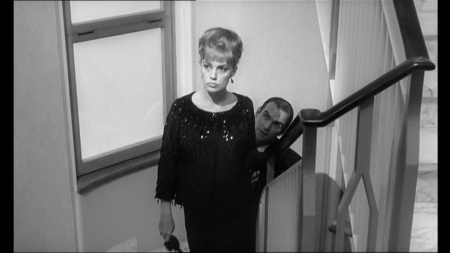
Losey was able to make Eve the same year, a true European art film based on a novel by thriller writer James Hadley Chase, a prolific British plagiarist who established a career penning American pulp fiction despite never having been to the States, armed only with a dictionary of slang and a map. The star, Stanley Baker, was Welsh, the son of a coal miner: his stardom anticipated that of later working-class heroes like Connery and Caine. Here he plays a novelist whose book has elevated him into high society, apparently cutting him off from the wellspring of his talent: but in fact he’s an utter fraud, who stole the manuscript from his dead brother. His destructive relationship with the title character, played by Jeanne Moreau, and with the vulnerable Virna Lisi, leads to tragedy.

Losey hated the book and got Jones to change the setting from Hollywood to Italy, incorporating footage captured at the Venice Film Festival. There’s no sense that this is meant to be a thriller, and the producers were aghast at its running time (168 minutes in Losey’s original cut). But the remaining hard-boiled elements help balance Losey’s tendency to self-serious artiness, resulting in one of his most fully-achieved films, and there’s a much stronger sense that Jones knows the kind of people he’s writing about here (his best character in The Damned is the sculptor played by Viveca Lindfors: Jones feels the strain when called upon to script the inarticulate). He also had a gift for acid camp, here personified by James Villiers as an aloof screenwriter, who protests at a wedding, “Why should an intelligent man like myself be subjected to this kind of tribal ritual?”

Losey likes stuffing his films with art: the setting of Venice gives him a valid reason to do so. In fact, art is inescapable there. And Baker’s tortured intellectual, self-destructive and lashing out, suits him admirably. The pairing with Jones (blacklistee Hugo Butler also worked on the script) was proving fruitful.

Next, Jones adapted King and Country (1964) from a radio play written by one of the participants in the true life story it told: during WWI, a private is tried for desertion. It’s a clear case of shell shock, what we now call PTSD, but the court of officers cannot accept that because they daren’t allow any excuse for a soldier not “doing his duty.”
The tiny budget and cramped sets are overcome by Losey putting the focus strongly on his central performances. Dirk Bogarde, his other favorite actor of this period, plays the officer charged with defending Hamp, played by Tom Courtenay. Courtenay, the star of The Loneliness of the Long Distance Runner (1962) and Billy Liar (1963) is another of the new breed of regional, working-class actors (in his case, Yorkshire) who retained their original accents and introduced a new, understated naturalism. There’s an electrifying contrast with Bogarde, a Rank Organisation matinee idol who successfully rebelled against his image and, like Losey, made the transition to the arthouse, eventually working with Fassbinder, Visconti and Resnais.
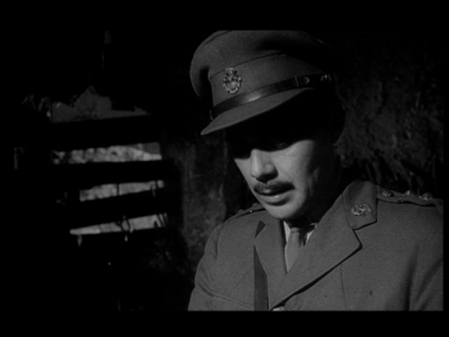
The play had been essentially a transcription from memory of the trial. At Losey’s behest, Jones opened it up to include a mock trial conducted by enlisted men in which a rat, captured from a horse carcass, is prosecuted. Jones wrote this with a good deal of slang which, when combined with regional accents and somewhat difficult studio conditions (the film was originally intended for television and shot in a mere three weeks) result in some difficulties in audibility and comprehension, but this actually enhances the realism.
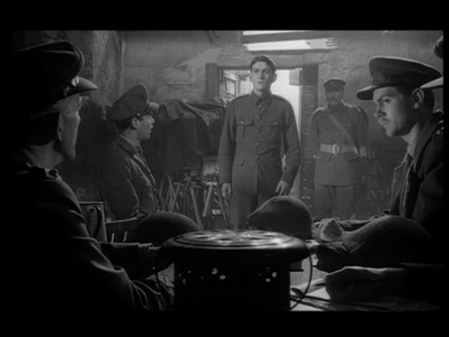
Unlike many reflections on the Great War (e.g. the recent 1917), Losey and Jones’ film eschews sentimentality and heroism. It is bitter and angry. The uneducated and traumatized Hamp, who has simply turned away from the guns and tried to walk home, is as guiltless as the rat and equally doomed. What cannot be admitted is that the war is unendurable.
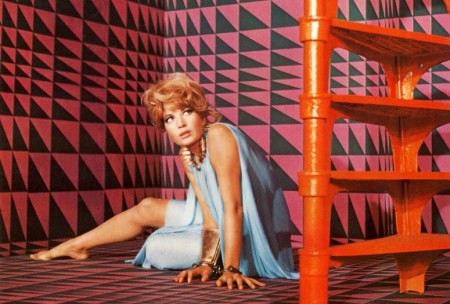
The final Jones collaboration was regarded at the time as an unmitigated disaster, and is still a film maudit. In fact, in his later career, Losey practically came to specialize in the film maudit, or what John Waters enthusiastically embraces as “the failed art film.” But Modesty Blaise (1966), based on a popular newspaper strip and intended as a parody of the James Bond franchise. It was, on the face of it, an incredible case of directorial miscasting. As Losey’s friend Richard Lester later said, “The last person that would come to mind to produce a movie that fits the adjective ‘zany’ would be Joe Losey.” “Antonioni,” claimed Losey, “said […] that it was ridiculous to try and parody the thing that one was oneself doing.”
Apart from the question of humor, Losey also strongly disapproved of the Bond films’ flippant “violence for violence’s sake,” an attitude that may seem quaintly prudish today, but it was important to him.

The resulting film, a pop art/op art pastiche based around nothing of any importance, is very attractive and, on paper, very funny. Jones was particularly successful at writing a camp villain for Dirk Bogarde to play with bleached blond hair, getting ironically overwrought about innocent lives wasted. “A father of two children, probably with a split-levek house in Woking, and a rubber plant in the lounge. Why can’t they be bachelors?!” At its best it hits a tone not elsewhere attempted and hard to pin down. When leads Monica Vitti and Terence Stamp abruptly burst into song (the film is not otherwise a musical and neither of them can really sing) the movie is not fracturing its own approach, it’s fulfilling it.
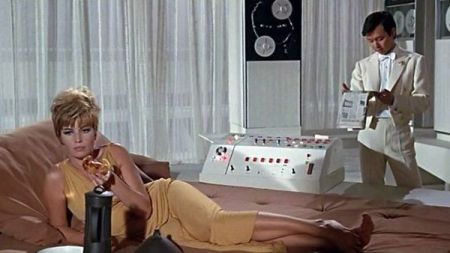
But part of the oddness is Losey’s approach and pacing, with his circling tracking shots which had now become a trademark: it moves like an arthouse drama, leaving way too much air around the witty dialogue. If you see it with an audience you can sense them trying to enjoy it, trying to hurry it along to be the thing it needs and deserves to be. Something like Barbarella (1968), carelessly shot and with about five good lines, works perfectly well, with a lot of burbling electronica to fill in the dead spots, whereas despite classic stuff like Bogarde pegged out on the desert sands calling out for “Champagne!”, Losey’s film seems to not know where the jokes are. Plus it’s 119 minutes long and it has no motor, because the central characters aren’t taking the situations seriously.
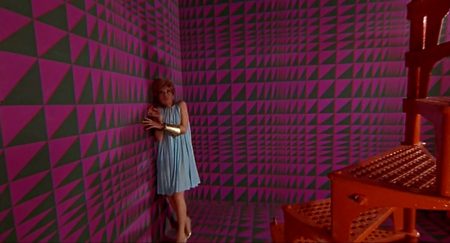
The film’s failure broke up the Losey-Jones partnership: Losey went on to direct Pinter screenplays Accident (1967) and The Go-Between (1971) while Jones worked on a scattershot collection of films without much apparent momentum or focus, but including one classic, Wake in Fright (1971).









